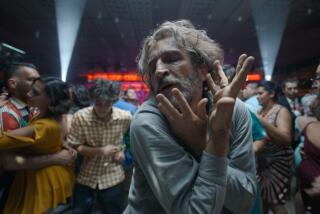Movie Review : ‘La Strada’ Takes the Spirit to Heart
SANTA ANA — Federico Fellini the fabulist, the director who provoked and sometimes perplexed with his hallucinatory imagery, had yet to emerge when “La Strada” was released in 1954. But Fellini the fable-ist was fully evolved.
Perhaps his most sentimental movie and a favorite among more mainstream audiences, “La Strada” is an urban fairy tale done up in the conventions of the famed Italian neo-realist style.
Poverty, social distortion, people in flux, a country still shellshocked by war--all are elements in this touching film, being shown tonight as part of the Bowers Museum’s Italian film series. But it is the romance, tragedy and lyricism of the heroine that holds us.
Fellini chose his wife, Giulietta Masina, to play one of his most memorable characters, Gelsomina, the Harpo Marx-faced waif. Sold to Zampano, a brooding, often brutal circus strongman played by Anthony Quinn, she is the innocent on the road, facing despair as fate stands tough against her, breaking down her optimism and purity. She is resilient but only to a point; the film is fueled by her growing losses in the face of a cynical world.
We first meet her as she clings to her mother during negotiations with the grimacing, grunting Zampano. He bought her sister years ago, and now that she is dead he needs someone to replace her in his meager traveling show. Gelsomina is the answer. Her mother sells her for 10,000 lire.
*
Zampano’s act, which be brings from town to town, centers on a ridiculous feat of strength: Laying on the clumsy theatrics, he breaks a chain wrapped around his chest. Gelsomina bangs the drum and tramps about like a clown. It suits her; she is enlivened by the crowd’s laughter.
But Zampano’s cruelty begins to erode her, until she is befriended by the Fool, an artful acrobat played by Richard Basehart. The dynamics among the three provide “La Strada” with its themes of man’s complexity: Zampano, the sensualist, represents the body while Gelsomina, a dreamer, is the spirit and the Fool, a thinker, is the intellect.
As strength overcomes more refined impulses, Fellini doesn’t capitulate to pessimism. He is only playing the realist (a far cry from his preferred role as the romantic). But even as Gelsomina and the Fool suffer, they remain true to themselves, and there lies their victory.
*
Masina is an unlikely heroine, the most fragile of leading ladies. It’s easy to be distracted by her acting, which is an acquired taste: She represents feelings, like a silent-movie star, instead of expressing them as most modern actresses would. Indeed, she can be annoyingly jejune. But Fellini felt, correctly, that hers was the right approach to convey a sort of trampled innocence.
She also can be seen Monday night in another, much odder Fellini movie, “Juliet of the Spirits” (1965). The finale of the outdoor “Celestial Cinema” series at the Muckenthaler Cultural Center in Fullerton, this film (Fellini’s first in color) presents Masina as a distraught housewife exploring her garish fantasy life.
* “La Strada” (1954) by Federico Fellini is being shown tonight at 7:30 at the Bowers Museum of Cultural Art, 2002 N. Main St., Santa Ana. $4, $3.50 for seniors and students, $1.50 for children 12 and under. (714) 567-3600. “Juliet of the Spirits” (1965) is being shown Monday at 8 p.m. at the Muckenthaler Cultural Center, 1201 W. Malvern Ave., Fullerton. $3. (714) 738-6595.
More to Read
Only good movies
Get the Indie Focus newsletter, Mark Olsen's weekly guide to the world of cinema.
You may occasionally receive promotional content from the Los Angeles Times.










